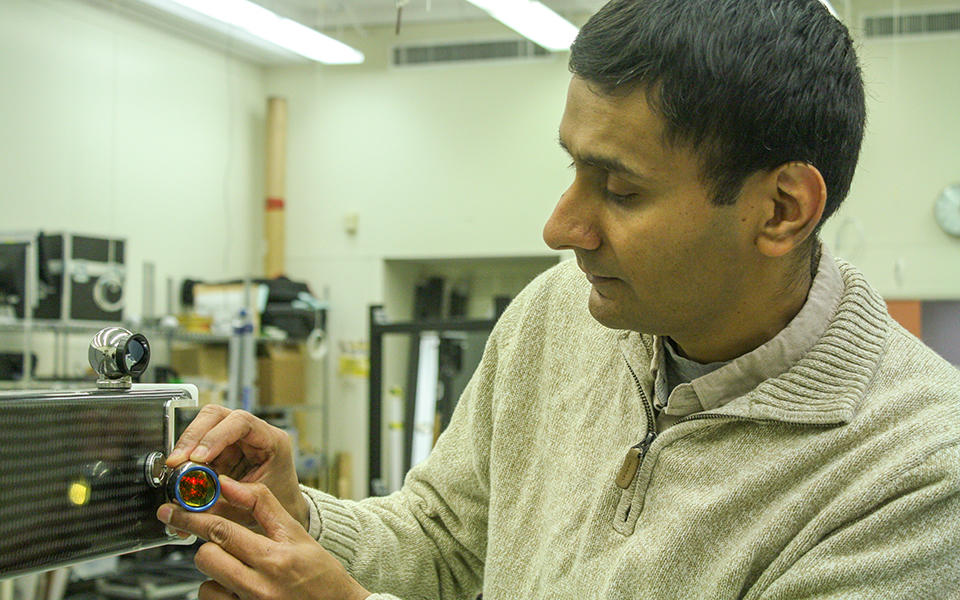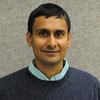Taking Measure
Just a Standard Blog

Adjusting a retroreflector for a laser tracker.
“Wow, that’s cool, but the meter was defined a long time ago, so what is really there for you to do?” This is the response I get from people when I tell them that I work in the length group at the National Institute of Standards and Technology (NIST). My reply is as short as I can make it — “I spend most of my time in the laboratory developing tests that become part of documentary standards that people in industry use to evaluate their measurement instruments.” At that, some people walk away, some fall asleep. For those still interested, I take them on a journey through how documentary standards for measurement instruments are made and why they are important. Let me take you on that journey and share with you some of the moments of pride I have felt over the past 15 years contributing in my own small way to documentary standards development for dimensional measurement systems.
First impressions of standards meetings
When I first came to NIST as a postdoc in late 2003, I was asked to develop a probe that could measure sizes of objects that are on the order of the width of a human hair. Three years later, my role expanded to working with complex instruments that measure length. Note that length measurement needs occur in many forms, such as the length of a cable, the circumference of a cylinder, the curved form of a lens, the sphericity of a ball, the topography of a plate, the inner dimensions of manufactured parts, etc. There are many different technologies needed to measure length in its many forms.
In early 2006, I was working with laser trackers, which are laser-based measurement instruments used, for example, in manufacturing aircraft. It was then that my supervisor invited me to go to my first documentary standards development meeting. The meeting was a revelation — not a lot seemed to happen, and what did happen was mind-numbingly boring. A group of very passionate people were sitting around a table arguing over the tiniest of details — the tense of a verb, the structure of a paragraph, the definition of a term.
I attended about five or six more meetings but couldn’t take it anymore. I finally asked my supervisor to release me back into the laboratory where I could enjoy spending every minute working with instruments, understanding error sources, and generally learning new things. My supervisor readily agreed, quoting the old managerial adage that “the success of the group lies in matching jobs to people, not people to jobs.” Hey, I didn't complain. At that time, I didn’t quite appreciate the effort that went into or the value of documentary standards. Laboratory research and documentary standards seemed worlds apart, and the link between the two, if any, seemed tenuous at best.
Why are performance evaluation documentary standards important?
Some years later, my supervisor asked me to buy a laser scanner, another laser-based measurement instrument somewhat similar to a laser tracker. I started looking at different vendors and realized that I could barely make sense of their accuracy specifications, and worse yet, I could not compare the specifications from one vendor to the next. This is a huge problem, probably something not appreciated by many. For instance, suppose you are in the market for a new computer. You can easily compare across manufacturers because the basic specifications, such as processor speed, RAM, hard disk size, screen size and resolution, are pretty standard. We take this for granted when we buy things in our daily life. I realized then the value of standardizing the specifications for these scanners so that I could not only understand them but also compare across models.
After buying a scanner, we now had an interesting problem at hand. We were only allowed to pay the vendor after we had verified that the instrument met specs, specs we never clearly understood in the first place. Over the next couple of weeks, after a lot of head-scratching, we devised any number of complex tests to figure out how well the instrument performed before we were finally able to sign off on it. This process once again reinforced in me the need for standardized tests — and someone to develop them — to inform buying decisions because most people in industry don’t have the time to devise complex tests to evaluate unclear specifications.
New appreciation for documentary standards
Even with new insights on the value of documentary standards, I continued to be happily employed in the laboratory learning new things about measurement instruments. In the late 2000s, I was spending a lot of time modeling errors in laser trackers and devising tests that would clearly reveal those errors. The validation of the mathematical models through carefully designed experiments resulted in many interesting peer-reviewed publications, which was a satisfying end goal by itself. I would have moved on, focusing on new technologies such as the laser scanner, but for a fortuitous intervention from my supervisor.
In the late 2000s, the International Organization for Standardization (ISO) began work on a new documentary standard for laser trackers. As it progressed within ISO, my supervisor reached out to me to contribute to the development of this standard. Alarm bells rang at the thought of having to sit through mind-numbing meetings in far-off locations around the world.
Luckily for me, though, my supervisor simply asked me to distill my years of learning into simple recommendations that could be fed into a documentary standard. It then occurred to me why he had allowed me such free rein in the laboratory over the years: because the heart of a documentary standard that evaluates performance is test procedures that reveal the errors inherent in an instrument. And the only way to come up with those test procedures is to become so intimately familiar with the instrument that you can comfortably make those recommendations.
I was pleasantly surprised to see that our recommendations were absorbed in their entirety by that committee, and the standard eventually was published in 2016. People around the world were going to use this standard — based on the work of my colleagues and me — to buy and sell laser trackers. I felt a sense of pride, purpose and accomplishment like I had never felt before.
After publishing the laser tracker standard, I focused on understanding laser scanners. I spent months mathematically modeling the systems, followed by years in the laboratory validating the models, eventually leading to a distilled set of test procedures to evaluate these scanners. This time, I led the effort to write the standard. Yes, standards meetings can at times be excruciating, but when you think about the greater good, it all becomes worth it. I am now leading the ongoing revision of a standard for laser trackers and contributing to other efforts such as standards for X-ray CT systems like those you might find in a hospital. Over the past 15 years, I have had the opportunity to contribute to numerous documentary standards activities, either directly or indirectly. I clearly see the progression from laboratory research to documentary standards, and how that ultimately helps industry, which is, after all, a core mission of NIST.
Concluding thoughts
Some years ago, I was traveling with my family and we were at the airport about to board a 13-hour international flight when I told them about laser trackers being used to build aircraft. I knew that it was quite possible that the aircraft manufacturer used my work to evaluate those instruments and thus, indirectly, I might have had a small role in the building of the aircraft we were going to be flying on. It felt good to know that the documentary standards I helped write, while they seem so abstract sometimes, have such a real-world impact on something people depend on to transport them safely around the world.
About the author
Related Posts
Comments
Greetings - Thanks so much for this wonderful piece - and thanks very much for your important contributions to standards. We all owe you a debt of gratitude. I certainly appreciate standards more than most, as I work at ANSI - but your piece reminded me again of how important it is for experts like yourself to participate in standards development. Thank you and be safe - Anne Caldas
You articulated that well Bala! I think I'll have the machine tool metrology students read this.
Thank you Jimmie.
Is anyone at NIST working on documentary standards for the instruments used for the identification of drugs?
John,
Yes, we have efforts in this area. Please see https://www.nist.gov/topics/organization-scientific-area-committees-for….
You can also see https://www.nist.gov/topics/drugs-toxicology for more info on the scientific research we are conducting.
Thank you for your question!
This excellent, excellent article has motivated me to ask that Mr. Muralikrishnan's group consider exploring the development of a research metrology standard for an embedded robotic 'Visual Servoing' capability for precision robotic assembly -- with robot payloads containing target indicia patterns on one or more of a payload's faces. Ideally -- classic barcodes or newer QR code patterns can be enhanced to contain application-specific dimensional data values and 6-degree-of-freedom orientation information -- usable for 'servo flying' robot end effectors to both pre-staging pose positions and attitudes and final terminal payload grasping robot motion.
Thank you for your feedback. Standards for robotics applications are in fact being pursued - please see ongoing work within NIST Engineering Laboratory here:
https://www.nist.gov/el/intelligent-systems-division-73500/programsproj…
This impressive account
is essentially about Measurement.
The only true knowledge.
It was a real pleasure to read your story it is an inspiring and to some point encouraging lesson…Thanks for sharing






I’ve been to the NIST campus in Gaithersburg near Washington DC and seen first-hand the enormous equipment and personal that work hard to develop new testing and calibration protocols. Our past success as an industrial, space and defense giant could not have been possible without institutions like NIST! May our national labs like this continue to flourish in the years to come.